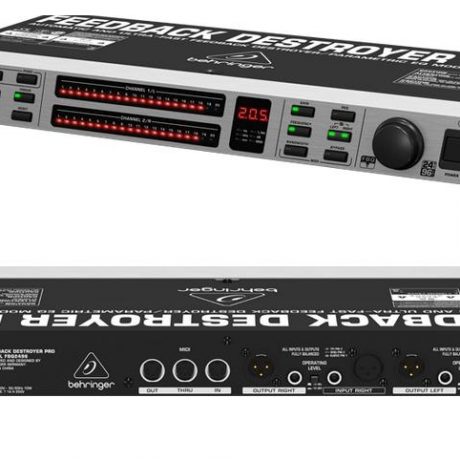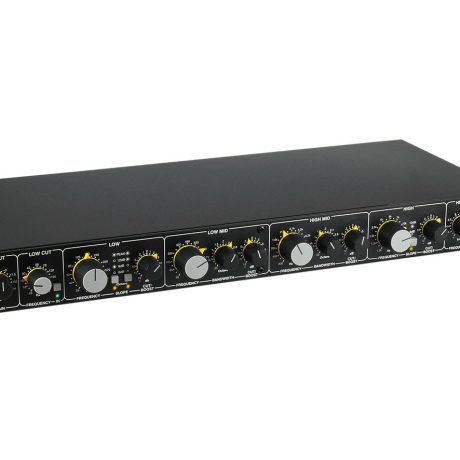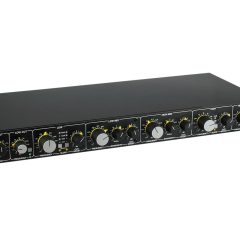| Content |
The Feedback Destroyer Pro FBQ2496 from Behringer is a Feedback Suppressor that uses an ultra-fast feedback detection algorithm. The unit automatically and "intelligently" locates up to twenty feedback frequencies per channel and sets extremely narrow notch filters to attenuate them, leaving the remainder of the program material virtually untouched.
A "Set-and-Forget" default setting plus the Panic button, allows the FBQ2496 to be set up and running in no time. The auto mode continuously monitors the mix, resetting programmed filters automatically, while the manual mode allows individual setting of up to forty fully parametric filters with frequency, bandwidth and gain adjustment.
Open MIDI architecture provides for future software updates and flexible communication with other digital devices. With the unit's various modes, mastering just about any live sound situation is effortless, while the option to use it as a creative sound-shaping tool is always available.
- Automatically and "intelligently" locates and modulates up to twenty frequencies per channel in response to the onset of feedback
- Fast feedback detection (less than 0.2 seconds)
- Ultra narrow notch filters for effective feedback suppression while maintaining the sonic integrity of the source material
- “Set and forget" default setting plus Panic button enable fast and easy performance
- Auto mode continually monitors the program material, resetting filters as necessary
- Single shot mode automatically detects and destroys feedback and locks the filter until reset manually
- Manual mode allows setting up of forty individual fully parametric filters with frequency, bandwidth and gain adjustment
- Open MIDI architecture for future software updates and flexible communication with other digital equipment
- Internal switching power supply for maximum flexibility, noise free audio, superior transient response plus low power consumption
| PRICE WITHOUT V.A.T.
BSS Opal FCS-966 Constant Q Graphic Eq
Graphic equalisers are found in just about every sound application, from room contouring to feedback control and general audio sweetening.
Traditionally, much general eq'ing takes place on the faders alone, but this restricts the use of the faders at each end of the scale for further precision eq work. So we provided the Opal FCS-966 with separate LF and HF contour filters which can change an overall sound balance without disturbing a detailed room or loudspeaker response.
These filters are very musical gentle boost and cut shelving filters which can be used to add (or remove) room effects that change with temperature, audience numbers or humidity.
All these effects can be easily made without disturbing the critical fader settings already made.
Constant Q Filters
The modern generation of graphic eq's
uses the Constant Q topology, pioneered by BSS Audio, which means that the filter width is constant whatever the fader gain setting.
Compared to the earlier 'gyrator' style of filters, Constant Q filters provide a smoother and more predictable interaction between adjacent faders and the resulting eq curve more closely resembles the actual fader positions.
More Gain Control Per Filter
Each eq fader has +/-15dB of adjustable gain, more than many competitive graphic eq's. The faders are long-throw 45mm types for precision control.
High Pass Filter
Also provided on the FCS-966 is a sweepable high-pass filter which can be used very effectively to restrict the low-energy output for better amplifier and loudspeaker performance. Stage monitors also benefit from the application of a high-pass filter to remove bass signals e.g. from vocal-only wedges.
Metering
BSS Audio believes in providing engineers with information, and the FCS-966's 8-segment led meter shows output level and warns of signal clipping within the eq. When the unit is switched to bypass, the meter will read the input level, allowing accurate matching of the 'dry' and equalised signals using the gain control.
Centre Bypass
When any eq fader is in its centre detent position, the filter is automatically bypassed, for optimum performance.
Input/Outputs
All the inputs and outputs of the FCS-966 are electronically balanced, with optional transformer balancing. To make installation of the FCS-966 easier, we've provided three differerent interface connectors: XLR-type, 1/4" TRS jack and Phoenix/Combicon screw terminals.
Relay Bypass
The EQ IN buttons switch the EQ path
into circuit. When switched out, or power fails, a high-quality relay switches the input signal directly to the output connectors.
Control Descriptions
Faders
30 EQ filter faders on ISO centres, each with nominal +/-15dB of gain. Positive centre-detent on 45mm long-throw precision faders.
HP Filter
Sweepable high pass filter, frequency adjustable from OUT (flat) up to 250Hz.
LF Contour
Smooth shelving filter, +/-6dB of gain at 50Hz
HF Contour
Smooth shelving filter, +/-6dB of gain at 14kHz.
GAIN
Used for overall unity gain adjustment. Adjustable from - infinity to +10dB.
CLIP
Triple-point clip detector that indicates red when the internal signal is clipping at any one of three critical points.
LED Meter
Shows output signal level (input signal when eq is bypassed) from -24dBu to +18dBu in 8 steps. |
The class-A circuit used in the EQ-73 is similar to the eq section in the classical 1073 module, without the high pass filter. Additional frequencies have been added and the mid frequency band uses two inductors, the higher value of the second one is used for the two lowest frequencies, 160 Hz and 240 Hz, to achieve a suitable response.
The sound character is warm, punchy, sweet and musical. These classic characteristics have been heard on countless recordings through the years and it is a versatile sound that works very well on most sound sources and in most genres. The essence of this sound is now available at a surprisingly low cost, making it available to nearly everyone.
The EQ-73 has stepped frequency controls that offers a wide selection of frequencies from 20 Hz to 24 kHz.
The Low and High frequency bands are shelving and the mid frequency band is of the bell type.
The control range is +/-15 dB for the two lower bands and +/- 18dB for the high frequency band.
There are separate bypass switches for all three bands.
The EQ-73 is made to be used together with one of our PRE-73 models that has an Insert jack. It can also be used with many other units that has a low level insert jack.
Combining a PRE-73 and an EQ-73, and using a UNITE rack kit to mount them together, one will get a 19-inch 1073-style unit at a low cost and with a great sound!
FEATURES
- Vintage Style electronics. No intergrated circuits in the signal path
- 3-band with a dual inductor based mid frequency band
- Stepped frequency selection
- A wide selection of frequencies from 20 Hz to 24 kHz
- Control range up to +/- 18 dB
- Separate Bypass switches for each band
- Tantalum capacitors in the signal path
- Made to be used together with one of our PRE-73 models with an Insert jack or any other unit with a low level Insert jack
- TRS jack for in-and output connection, the nominal working level is around 18 dBu
- Selectable ground lift switch
- External power supply to avoid interaction with the audio circuits
- Great sound that suits most sound sources and genres
- A solid build quality that will last many years of normal use
| INPUT
Connectors: 1/4" TRS, female XLR (pin 2 hot)
Type: Electronically balanced/unbalanced, RF filtered
Impedance: Balanced 40k ohm, unbalanced 20k ohm
Max Input Level: >+21dBu balanced or unbalanced
CMRR: >40dB, typically >55dB at 1kHz
OUTPUTS
Connectors: 1/4" TRS, male XLR (pin 2 hot)
Type: Impedance-balanaced/unbalanced, RF filtered
Impedance: Balanced 100 ohm, unbalanced 50 ohm
Max Output Level: >+21dBu balanced/unbalanced into 2k ohm or greater
>+18dBm balanced/unbalanced (into 600 ohm)
SYSTEM PERFORMANCE
Bandwidth: 20Hz to 20kHz, +0.5/-1dB
Frequency Response: 50kHz, +0.5/-3dB
Dynamic Range: Typicall >112dB
Signal-to-Noise: Typically >95dB
THD+Noise: | The vintage-style fully stereo 1974 four band Parametric Equaliser provides exceptional analogue musicality and sonic clarity, taking it\'s inspiration from 1970\'s-era gear. It has the ability to perform subtle shaping for mastering purposes that require a delicate touch and easy recall, but is just as capable of tonal sculpting, adding the analogue warmth and character that is near impossible to emulate in the digital domain.
Get immersive with the stereo operation, with one set of controls for both channels. The versatile design features dual channel precision stepped potentiometers, providing exceptional accuracy for fast and simple recall. The fully variable bandwidth allows you to control the parametric mid bands, making adjustments as surgically precise or as broad and natural sounding as you could ever require. Fully adjustable low and high cut filters are also included, ideal for tuning out undesirable signals at the frequency extremes. It also features switchable slopes on the low and high bands, allowing you to alter the focus at the top and bottom frequencies plus a low peak setting that magnifies the bottom end. The 1974 is perfect for tonal shaping, staying true to the sound of the 70s and ideal for any musician.
Genuine Stereo Operation with Indented and Accurate Potentiometers. The genuine stereo linked operation of the 1974 makes adjustment quick and extremely simple using just one set of controls to alter both channels. Gone is the wasted time spent fiddling about on every control trying to match the settings of the left and right channels with each other. The 1974 uses precision potentiometers, each one being matched for left/right accuracy to within fine tolerances by our trained technicians, so that both channels operate identically, and also have indented operation, providing exceptional accuracy for fast and simple recall.
Fully Parametric with Totally Variable Bandwidth. The 1974 is a true \'parametric\' equaliser, with the four bands having fully variable frequency controls and offer cut and boost of +/-12dB\'s. However, unlike EQ\'s with a no bandwidth adjustment, or a simple switch, the two mid bands have completely variable filter bandwidth controls enabling the user to focus in on very narrow sections of the audio spectrum or apply a broad natural sounding filter, or, of course, anything in between the two. This makes the 1974 incredibly versatile and capable of modifying everything from subtly fine tuning mixes to tone sculpting problematic recordings.
Variable Low and High Cut Filters. The 1974 also includes fully variable low and high cut filters, ideal for tuning out undesirable signals. The low cut (otherwise known as High Pass Filter) having a range of 10Hz-225Hz and the high cut (otherwise known as Low Pass Filter) 4kHz-32kHz. The beauty of being fully variable is that, unlike fixed frequency filters, it is easy to sweep both controls to find the perfect setting and remove sounds with pinpoint accuracy. This is especially useful when bracketing individual tracks where it will be necessary to cut the bass to remove rumble and top to remove hiss, as these undesirable signals will just add up as the tracks are layered. For instance, cut everything instrument below 100Hz except those within that spectrum, such as the kick, bass or synths etc to provide extra headroom to work and also tighten up the bass making it sound less muddy. And likewise for the high frequencies.
Switchable Slope Setting. Very few analogue parametric equalisers have an adjustable slope on the low and high band filters, and is yet another feature of the 1974 that allows you to take control of your audio. The filter slopes of the 1974 have been chosen for their musicality - allowing you to adjust the focus of the audio at the bottom and top ends of your recording but not so harsh as to be a very noticeable brick wall filter. At the bottom end slopes of 6, 9 and 12dB per octave plus a Peak setting are available, and at the high end 6 and 12dB\'s per octave.
The Peak setting is quite a unique feature in that it adds a narrow bell shape to the 12dB per octave low band filter at the knee frequency just before it rolls off. Especially useful on kick drums, it magnifies and gives extra weight to the hit whilst still filtering out any subsonic junk and without muddying the lower mid. It\'ll give your kick an added sense of power and precision.
Features:
- Vintage-style four band Parametric Equalisation which takes it\'s inspiration from 1970\'s-era analogue gear.
- Delivers classic sonic clarity and control at an affordable price.
- Genuine stereo operation with one set of controls for both channels.
- Indented and accurate potentiometers, providing precision for quick and simple recall.
- Variable low and high cut filters allow you to perfectly tune out any undesirable signals.
- Fully variable bandwidth provides absolute control for the parametric mid bands.
- Switchable slope plus low peak settings allows you to adjust the focus and magnify the bottom end.
- True hardware bypass for accurate A/B comparisons.
- Internal Low Hum Toroidal Linear Power Supply with Voltage Selector Switch.
- Classic Drawmer Build Quality with Rugged Steel Chassis and Aluminium Front Panel.
- Designed and manufactured by Drawmer in the UK.
|
1215 Dual 15-Band Graphic Equalizer
The dbx 12 Series were designed to meet the needs of the most
demanding sound reinforcement environments, while offering the
simplicity of straightforward controls. The 1215 provides standard
features like dual channels, 15 2/3 octave bands, ISO frequency
centers, +/-12 dB input gain range, and switchable 40Hz/18 dB per
octave low-cut filters, but also includes other thoughtful features.
These include 45 mm faders; selectable +/-6dB or +/-15dB boost/cut
range for precise gain adjustments; XLR, barrier strip, and 1/4'' TRS
connectors for installation ease; balanced inputs and outputs for quiet
operation; and chassis/signal ground lift capabilities for quick hum isolation.
The visionary design of the dbx 12 Series makes your job easier.
The dbx 12 Series Equalizers were precision engineered to provide years
of maintenance-free operation in any application. The magnetically isolated
transformer, electronically balanced/unbalanced inputs and servo balanced/
unbalanced outputs, RF-filtered inputs and outputs, and power-off hard-wire
relay bypass with 2 second power up delay were steps our engineers took
to ensure compatibility for all installations. Only the best components were
utilized, yielding a 10Hz to 50kHz frequency response, greater than 90dB SNR
(ref +4dBu), less than 0.005% THD +Noise (1kHz at +4dBu), and interchannel
crosstalk of less than -80dB from 20Hz to 20kHz. All this attention to detail
is contained in a 2U steel/aluminum chassis.
- Switchable boost/cut ranges of ±6 or ±15 dB
- Electronically balanced/unbalanced inputs
- Servo balanced/unbalanced inputs
- RF filtered inputs and outputs
- XLR, Barrier Strip, and 1/4" TRS connectors
- -12dB/+12dB input gain range
- 18dB/octave 40Hz Bessel low-cut filter
- Chassis/signal ground lift capability
- Internal power supply transformer
- Power-off hardwire relay bypass with 2-second power-up delay
|

















Reviews
There are no reviews yet.